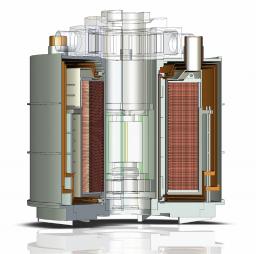
Partial cross-section of the hybrid magnet for the LNCMI. The transparent components are the existing conventional magnets and their connections to the cooling system. The superconducting magnet will be fitted with double pancake coils and enclosed within a cryostat measuring 2 m high and 2.3 m in diameter.
At the request of the National High Magnetic Fields Laboratory (LNCMI) in Grenoble, SACM has been studying the feasibility of a superconducting magnet with a field of 8.5 tesla to be used with existing conventional high field magnets (35 tesla) to provide a hybrid assembly capable of generating a field of 43 tesla within a diameter of 34 mm.
This superconducting magnet will have an internal diameter of 1 m and a height of 1.4 m. It would be subjected to intense mechanical and electrical stress should the field from the central conventional magnets collapse suddenly. In order to provide for the best possible safety of the superconducting magnet in the event of such an incident, the design adopts a strategy of cooling the conductor by means of an internal channel carrying superfluid helium. This will provide an energy reserve greater than the energy dissipated by the conventional magnets.
SACM carried out initial magnetic, electrical, mechanical and thermal design work on the magnet between 2007 and 2010. We have also established the basic specification and carried out mechanical measurements on samples of the conductor. Building on this initial work, the CNRS and the CEA have set up a collaboration within which IRFU/SACM will provide engineering designs for the superconducting magnet and is safety systems. The cryogenics systems will be shared between the CEA and the CNRS, the former providing the local interfaces and magnet services, and the latter designing the 1.8 K liquefaction system and pump together with the control and instrumentation.
• superconducting magnet physics and technology › Superconducting Magnets for Particle Physics Research
• Accelerators, Cryogenics and Magnetism Division (DACM)
• LEAS

